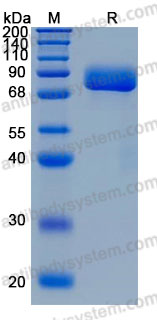Catalog No.
AHF05001
Biological activity
Measured by its binding ability in a functional ELISA. Immobilized recombinant human EPHA5 (Cat #: AHF05001) at 2 µg/mL (100 µL/well) can bind recombinant mouse Ephrin-A2 with a linear range of 0.16-10 ng/mL.
Expression system
Mammalian Cells
Species
Homo sapiens (Human)
Protein length
Ser56-Gln572
Nature
Recombinant
Endotoxin level
<0.1 EU/μg of the protein by the LAL method.
Purity
>90% as determined by SDS-PAGE.
Accession
B7ZKW7
Applications
Bioactivity, ELISA, Immunogen, SDS-PAGE, WB
Form
Lyophilized
Storage buffer
Lyophilized from a solution in PBS pH 7.4, 5% Trehalose, 5% Mannitol.
Reconstitution
Reconstitute in sterile water for a stock solution. A copy of datasheet will be provided with the products, please refer to it for details.
Shipping
In general, proteins are provided as lyophilized powder/frozen liquid. They are shipped out with dry ice/blue ice unless customers require otherwise.
Stability and Storage
Use a manual defrost freezer and avoid repeated freeze thaw cycles. Store at 2 to 8°C for one week. Store at -20 to -80°C for twelve months from the date of receipt.
Alternative Names
receptor protein-tyrosine kinase, EPHA5
EPHA5 regulates antifungal innate immunity by phosphorylating EPHB2 and Dectin-1., PMID:40489568
EPHA5 promotes cell proliferation and inhibits apoptosis in Follicular Thyroid Cancer via the STAT3 signaling pathway., PMID:40263257
Case report: A panorama gene profile of ovarian cancer metastasized to axillary lymph node., PMID:39925800
Genome-Wide Scans for Selection Signatures in Haimen Goats Reveal Candidate Genes Associated with Growth Traits., PMID:39857271
Immunohistochemical expression of ephrin receptors in neuroendocrine neoplasms: a case-series of gastroenteropancreatic neuroendocrine neoplasms and a systematic review of the literature., PMID:39425842
[Clinicopathological analysis of gastric adenocarcinoma with elevated serum alpha-fetoprotein and enteroblastic differentiation]., PMID:39034804
A pan-cancer analysis of EphA family gene expression and its association with prognosis, tumor microenvironment, and therapeutic targets., PMID:38952552
mRNA-lncRNA gene expression signature in HPV-associated neoplasia and cervical cancer., PMID:38946889
Identifying therapeutic target genes for migraine by systematic druggable genome-wide Mendelian randomization., PMID:38867170
Identification of New Pathogenic Variants of Hereditary Diffuse Gastric Cancer., PMID:38605661
ISL1 and POU4F1 Directly Interact to Regulate the Differentiation and Survival of Inner Ear Sensory Neurons., PMID:38267260
Analysis of a Four-Component Competing Endogenous RNA Network Reveals Potential Biomarkers in Gastric Cancer: An Integrated Systems Biology and Experimental Investigation., PMID:38073751
Role of interferon alpha-inducible protein 6 in modulating the proliferation, apoptosis and senescence of oesophageal squamous cell carcinoma cells., PMID:37661181
IL-17 promotes melanoma through TRAF2 as a scaffold protein recruiting PIAS2 and ELAVL1 to induce EPHA5., PMID:37481078
Crystal structure of the kinase domain of a receptor tyrosine kinase from a choanoflagellate, Monosiga brevicollis., PMID:37310965
To be, or not to be: the dilemma of immunotherapy for non-small cell lung cancer harboring various driver mutations., PMID:37261523
Identification of tumor mutation burden-associated molecular and clinical features in cancer by analyzing multi-omics data., PMID:36911742
May EPH/Ephrin Targeting Revolutionize Lung Cancer Treatment?, PMID:36613532
The impact of single nucleotide polymorphisms on return-to-work after taxane-based chemotherapy in breast cancer., PMID:36598552
YB-1 regulates mesothelioma cell migration via snail but not EGFR, MMP1, EPHA5 or PARK2., PMID:36550787
Immunohistochemical evaluation of forkhead box A1 and EphA5 markers in serous ovarian carcinomas, and their impact on the clinical outcome of patients., PMID:36345952
Construction and analysis of a lncRNA-miRNA-mRNA competing endogenous RNA network from inflamed and normal synovial tissues after anterior cruciate ligament and/or meniscus injuries., PMID:36324509
Association between EPHA5 methylation status in peripheral blood leukocytes and the risk and prognosis of gastric cancer., PMID:36164608
EPHA5 mutation was associated with adverse outcome of atezolizumab treatment in late-stage non-small cell lung cancers., PMID:36123678
Deficiency of the bZIP transcription factors Mafg and Mafk causes misexpression of genes in distinct pathways and results in lens embryonic developmental defects., PMID:36092713
Pharmacogenetics of taxane-induced neurotoxicity in breast cancer: Systematic review and meta-analysis., PMID:35892315
The immune microenvironment features and response to immunotherapy in EBV-associated lymphoepithelioma-like cholangiocarcinoma., PMID:35780451
Expression of EPHA5 in lung adenocarcinoma is associated with lymph node metastasis and EGFR mutation., PMID:35332588
Transcriptome-guided resolution of tumor microenvironment interactions in pheochromocytoma and paraganglioma subtypes., PMID:35088383
Gene by environment interaction mouse model reveals a functional role for 5-hydroxymethylcytosine in neurodevelopmental disorders., PMID:34949667
EphA2 and Ephrin-A5 Guide Eye Lens Suture Alignment and Influence Whole Lens Resilience., PMID:34854885
EPHA5 Enhances the Stemness of Non-small cell lung cancer Cells Through Activating the Wnt Signaling Pathway., PMID:34761594
A review on the role of different ephrins in glioma., PMID:34688637
Long noncoding RNA ZFAS1 suppresses osteogenic differentiation of bone marrow-derived mesenchymal stem cells by upregulating miR-499-EPHA5 axis., PMID:34655661
Sarcomatoid hepatocellular carcinoma: From clinical features to cancer genome., PMID:34331411
The Expression Profile and Prognostic Values of EPHA Family Members in Breast Cancer., PMID:34221956
Deep learning model reveals potential risk genes for ADHD, especially Ephrin receptor gene EPHA5., PMID:34109382
Expression Pattern and Prognostic Value of EPHA/EFNA in Breast Cancer by Bioinformatics Analysis: Revealing Its Importance in Chemotherapy., PMID:33977106
1800 MHz Radiofrequency Electromagnetic Field Impairs Neurite Outgrowth Through Inhibiting EPHA5 Signaling., PMID:33912567
EPHA5 mutations predict survival after immunotherapy in lung adenocarcinoma., PMID:33288738
PDL1 high expression without TP53, KEAP1 and EPHA5 mutations could better predict survival for patients with NSCLC receiving atezolizumab., PMID:33246647
Ephrin Receptors (Eph): EphA1, EphA5, and EphA7 Expression in Uveal Melanoma-Associations with Clinical Parameters and Patient Survival., PMID:33007931
EPHA5 mutation predicts the durable clinical benefit of immune checkpoint inhibitors in patients with lung adenocarcinoma., PMID:32759987
Eph receptors as cancer targets for antibody-based therapy., PMID:32593404
Gain-of-function genetic screen of the kinome reveals BRSK2 as an inhibitor of the NRF2 transcription factor., PMID:32546533
Alternative proteins are functional regulators in cell reprogramming by PKA activation., PMID:32324228
EPHA5 mutation impairs natural killer cell-mediated cytotoxicity against non-small lung cancer cells and promotes cancer cell migration and invasion., PMID:32234341
Characterization of epigenetic and transcriptional landscape in infantile hemangiomas with ATAC-seq and RNA-seq., PMID:32223448
EphA5 knockdown enhances the invasion and migration ability of esophageal squamous cell carcinoma via epithelial-mesenchymal transition through activating Wnt/β-catenin pathway., PMID:31956298
Racial differences in characteristics and prognoses between Asian and white patients with nonsmall cell lung cancer receiving atezolizumab: An ancillary analysis of the POPLAR and OAK studies., PMID:31583695

